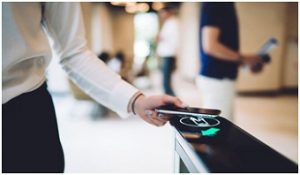
If you’re a security or facilities manager, you may already be aware of the quiet revolution that’s taking place across businesses and organisations up and down the country. There’s no doubt that using a smartphone or mobile device in place of traditional credential and access control is a growing trend that’s only been sped up by the pandemic. It’s true that many businesses are still very much focused on remote working, although many are now starting to implement new-and-improved strategies that are better suited to protect the workforce moving forward.
As the next normal becomes clearer, businesses will be reviewing procedures such as access control, occupancy monitoring, reducing touch points and tracking visitors. Mobile ID systems are ideally suited to this task. But what are the key reasons for considering such a setup?
But why is this new technology so well-suited to future-proof your physical access system, and why is it becoming so popular? Have you seen just how vulnerable outdated Proximity card technology can be? Low-frequency 125kHz cards can be cloned in a matter of seconds with the use of cheap, readily available tools. Despite their weaknesses, they are still used by a huge majority of businesses – big and small.
Replacing such a system with a mobile-enabled system is one of the best ways to increase security ten-fold. Thanks to a cloud-based infrastructure, mobile ID offers best-in-class security and cryptography. All smartphones include two industry-standard features that make them perfect for operating a secure, contactless credential. Bluetooth Smart and NFC (Near Field Communication) make them the best product to operate such a credential via a secure app. If you’re looking for best-in-class security in 2021, mobile access is most definitely the way forward.
Reducing touch points and the adoption of touchless facilities has become a key priority for businesses in the wake of COVID-19. Even as businesses start to return to the office and operate a home/office split, it will be imperative that unnecessary contact is kept to an absolute minimum between staff. The traditional issuance of identification and access control credentials can pose problems in this regard.
Facility and security managers who are responsible for onboarding and processing ID have done the process face to face. Mobile access makes it possible to carry this process out without people coming into direct content. First, the security manager has access to a secure portal, allowing them to create, manage and edit credentials anywhere.
They can upload and remotely transfer mobile ID and access control credentials directly to users’ smartphones over the air. Via the secure app, users can view and see their credentials and immediately begin using it for ID and access control by simply placing their smartphone over card readers.
The way in which we work has changed for good. Even as more people return to the office, a majority of businesses will be operating a home/office split indefinitely. This once again reinforces the need for a smarter, more adaptable onboarding system. Implementing mobile ID is the perfect way of doing this: over-the-air delivery of credentials and security data is now a given, helping businesses create the perfect balance between the home and the office. No longer do people have to come into the office for the onboarding process.
Ok, so mobile ID is the perfect way of increasing security and adapting workplaces to a post-COVID way of working. And we’ve not even touched on the most obvious advantage yet: Convenience. How many times have you forgotten your ID card? We’re sure it’s more times than you forget your smartphone. These powerful processors have become intertwined with the way we carry out tasks on a daily basis. They’re so vital that people will soon notice if they’ve forgotten it.
From an employee’s perspective, mobile ID and access control is simple, convenient and extremely user-friendly. More and more businesses are realising the value mobile ID can have for enhancing the work experience as well as security.
From the employer’s perspective, mobile ID means it’s easier for administrators to manage access and credentials. Future-proofing access control now will ensure that in the longer term, mobile ID is well worth the investment. The annual expenditure of printing ID cards and purchasing credentials can be vast, while reissuance costs can also quickly add up for larger organisations. These issues are a thing of the past for businesses using mobile ID.
Until mobile ID, new and improved credentials’ main focus was on increasing security. Mobile ID not only delivers that, but it also provides a more convenient way of accessing the office in a way that’s perfectly suited to returning to the office. If there was ever a time to upgrade, now is the time. Summing up, mobile access is changing the way we access the office by:
• Eliminating weak links in security systems such as outdated legacy card technologies
• Eradicating the need for touch points across multiple areas of the workplace
• Enabling a smarter, more flexible approach to onboarding
• Increasing convenience – for both employers and employees.











